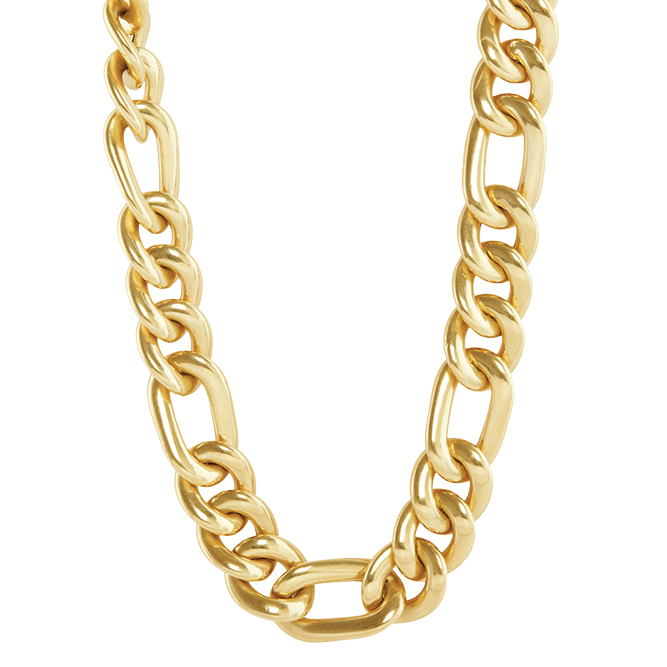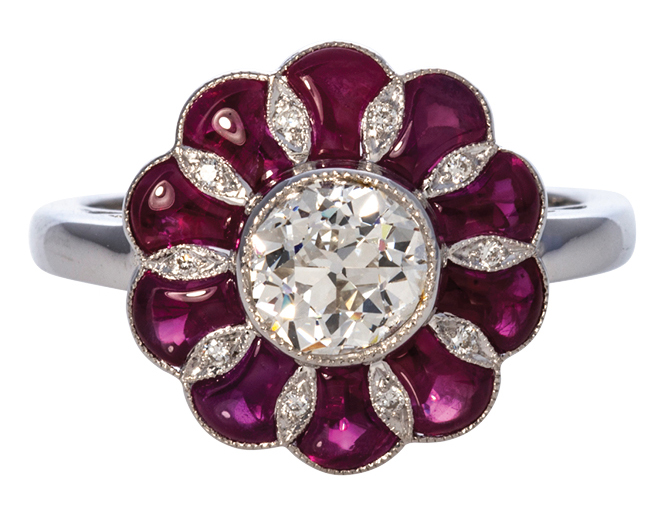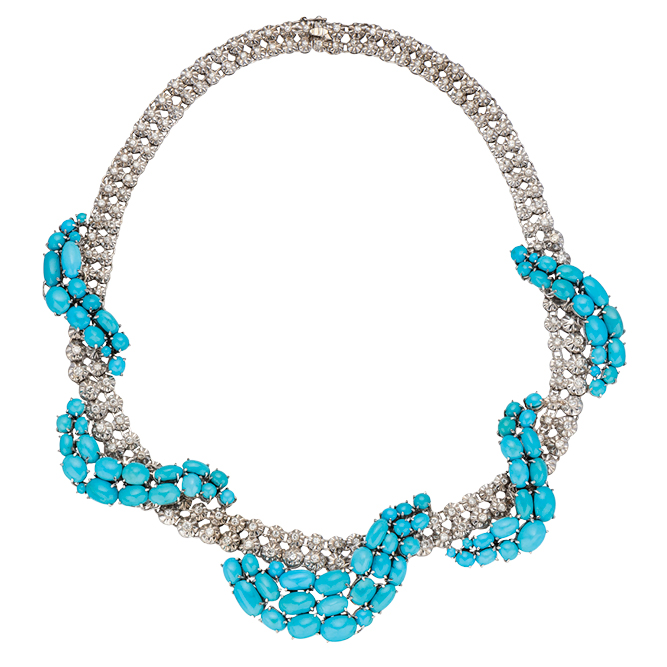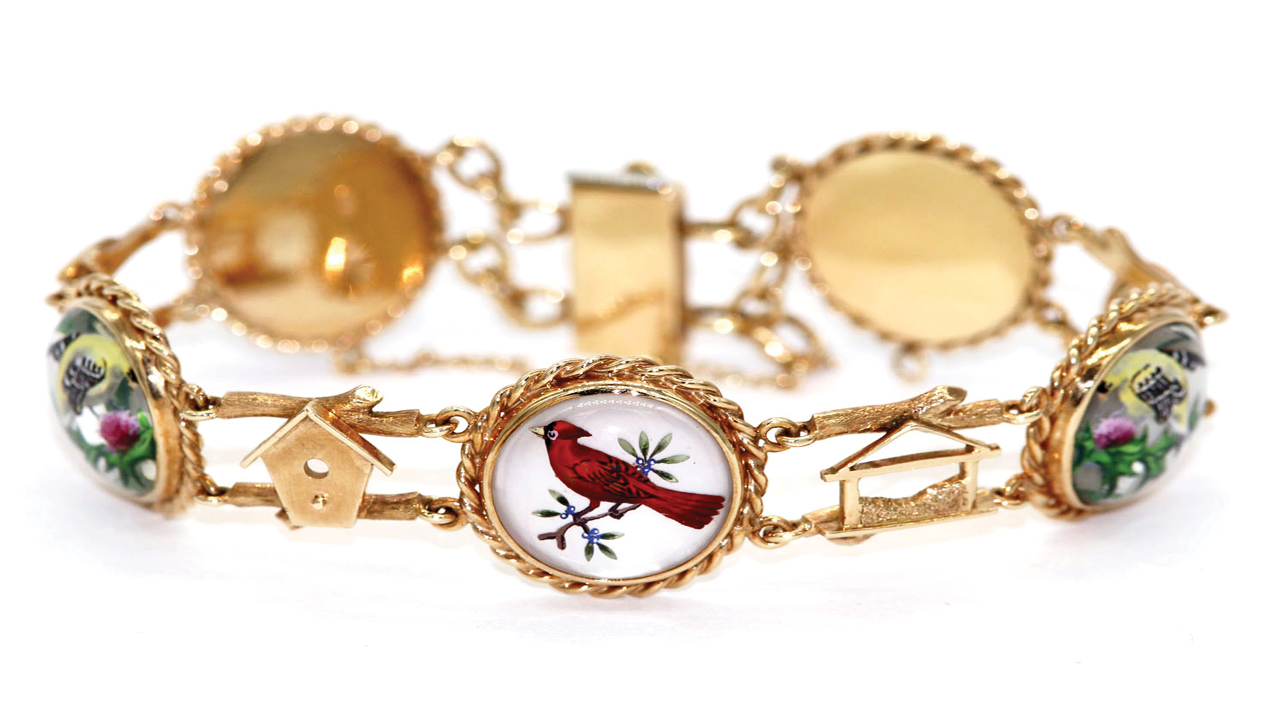Whether you’re expanding the estate department of your store or just opening, there are certain key aspects to building a strong offering. These include sourcing pieces that fit the cyclical trends of antique and vintage jewelry, making sure the styles pair well with your existing contemporary designs, and giving your salesperson the knowledge and tools to sell them.
“The vintage conversation is in the zeitgeist, so there’s real scope for contemporary retailers to include vintage jewelry in their assortment,” says Randi Molofsky, founder and owner of brand development agency For Future Reference. While her store primarily represents modern independent designers, she recently expanded it to include a curated vintage selection for stores looking to launch estate collections.
“Besides the idea that pre-owned jewelry is good for the planet, there is the romantic essence of jewelry that has stood the test of time,” she explains. “And it certainly underscores the fact that fine jewelry does not lose value but … continues to bring joy to new generations of owners.”
A preference for the unique
“Our estate offering continues to grow every year,” says Laura Freeman, owner of Broken English Jewelers, which has stores in Los Angeles and New York. “More and more customers want pieces that are one-of-a-kind or have some kind of story. They also want something unique from their friends and acquaintances.”


Given the increasing demand, she continues, “it’s also important to offer a variety of styles and periods in your estate assortment that work well with each other and with the modern jewelry designers you carry.”
The Internet connection
Social media has played a big role in creating a new customer base for older pieces with character—those that evoke a sense of nostalgia while still feeling fresh and relevant. Mary Leppert of retailer Metalmark—which has stores in Denver, Colorado, and Phoenix, Arizona, in addition to its home base of Carmel, Indiana—has witnessed the impact of social media on the growth of its estate departments.
“Customers who aren’t familiar with certain eras or styles can find them on Instagram,” she says. “There are also hashtags that keep lesser-known designers from different eras alive and inspire the consumer to check out these homes that are more accessible than the big-name brands.”
Knowledge takes you far
All respondents agree that consumers have learned more about antique and vintage jewelry in the last five to ten years.
“Our antique and vintage customers are very knowledgeable, especially if they’ve been buying pieces for a long time,” says Freeman. “They know what they’re buying. They also know the collectibles. So we’ve learned from each other and expanded our selection based on our own aesthetic as well as what’s desirable for our customers.”
An estate department is a natural fit for Croghan’s Jewel Box in Charleston, South Carolina. “Our store is over 100 years old and is located in a historic city that attracts millions of visitors each year,” explains second-generation co-owner Rhett Outten. “It makes sense for us to offer antique and estate jewelry because we love history, our customers collect it, and visitors are here to experience it. For us, mixing old with new is part of our culture.”


What is popular?
Molofsky strives to broaden consumers’ vintage horizons.
“Traditionally, retailers focus on signed pieces from prestigious houses, but my goal is to introduce jewelry lovers to unsigned pieces from the 1920s to the 1980s,” she says. “Older, fine jewelry has tremendous value because production costs were lower, as were gold prices, and we don’t artificially inflate prices to reflect the current market.”
Stylistically, she continues, “there is an interest in statement pieces from the ’60s, ’70s and ’80s with bold silhouettes in yellow gold. There is a return to large button earrings, necklaces, oversized bangles and chunky cocktail rings with bold gemstones.”


Broken English sells “a whole range of Victorian lockets, rings, brooches, diamond earrings, snake pieces and necklaces from different eras,” says Freeman. “I also think people are drawn to the ’70s pieces because they are elegant, sexy and timeless. The signed pieces that sell best for us are Cipullo, Cartier, Tiffany, Bulgari, Belperron and anything with a French stamp.”
As for Croghan’s Jewel Box, “most of our big sales are rings: vintage engagement styles, cocktail looks with colored stones, signet and crest rings,” says Outten. “We find that people are more attracted to the uniqueness and craftsmanship of these pieces than the desire to own a signed piece. Additionally, Victorian earrings and chunky gold pieces from the ’50s to ’70s are always a hit.”
Leppert’s sales come primarily from English reverse crystal, Victorian watch chains, Tubogas and Italian-made chains from the ’60s and ’70s, and eye-catching, wide bracelets.
Sales staff should familiarize themselves with time periods, maker’s marks, hallmarks and provenance, she advises. “It’s essential to train your team so they are equipped with all the information they can offer. This definitely helps and may close the sale.”
supply and demand
“Demand for certain signed pieces has driven up prices,” Freeman admits. “Zodiac signs by Cartier and Tiffany and Monete necklaces by Bulgari are now such sought-after collectors’ items. Everything (by) Cipullo is sold before it hits the market. Some items are available at a higher price because you can’t find them anymore.”
At Croghan’s, says Outten, “we price fairly and try to offer reasonable prices. We let the value speak for itself.”
In general, it is becoming increasingly difficult for shop owners to obtain antique and vintage jewelry.
“Selling these categories takes a lot of work: scouring the market, appraising, and knowing your history,” says Molofsky. “Most retailers don’t have time for that extra work. I hope to offer this service to our trusted retail partners and provide new estate finds so they can sell with confidence.”
Despite these challenges, Freeman believes that “today, every retailer should consider having a dedicated display case for antiques and vintage pieces.”
Four styling and presentation tips
1. Sort by color
This “draws the eye to a display case and keeps the customer’s attention longer,” suggests Mary Leppert of Metalmark. The display “can be from different eras, which shows customers that they don’t have to limit themselves to one era.”
2. Combine properties with complementary newer designers
“Temple St. Clair, Single Stone, Elizabeth Locke and Marla Aaron, all inspired by history, pair well with the antiques in the store,” says Rhett Outten of Croghan’s Jewel Box, which often combines or layers old items with modern ones in its displays.
“Some of our contemporary designer collections are a nod to the past and blend seamlessly with antique and vintage pieces,” confirms Laura Freeman of Broken English.
3. Distinguish the antiques
“Our antique and vintage jewelry is kept together in a special area of the store,” says Outten. “Then we sort by category. When possible, we also use antique boxes for special pieces and have signs explaining the meaning (of the pieces).”
4. Get creative
“There are no rules when it comes to combining modern and old,” says Randi Molofsky of For Future Reference. “You can show off an 1890s cuff with a modern bangle by Harwell Godfrey, or a large 1960s necklace with a Buddha Mama Hamsa pendant.”
Main image: A 14k yellow gold colored crystal bracelet, circa 1950s to 1960s. (Metalmark)
This article is from the July-August 2024 issue of Rapaport Magazine. You can find more articles here.
Stay up to date by signing up to our diamond and jewelry industry news and analysis..

